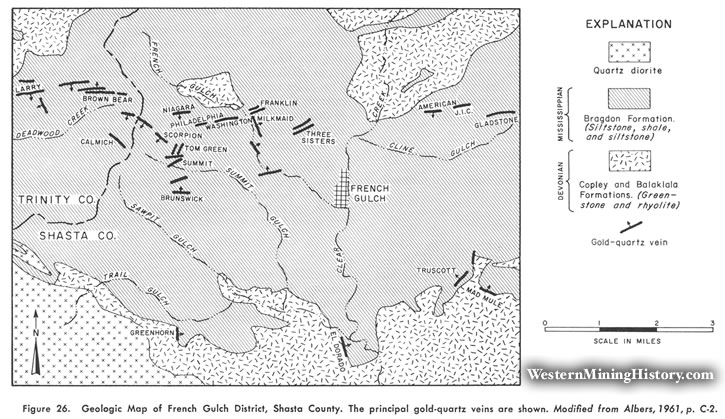Location
This district lies astride the Shasta-Trinity County line in the general vicinity of the town of French Gulch and includes the Deadwood area to the west. It is the most important lode-gold district in the Klamath Mountains.
History
French Gulch was originally prospected in 1849 by French miners, from whom the town received its name in 1856. Clear Creek, which drains the area, yielded large amounts of placer gold at this time. The Washington mine, discovered in 1852, was the first quartz mine worked in Shasta County. From around 1900 to about 1914 the output for the district averaged between $300,000 and $500,000 worth of gold per year. There was some activity during the 1920s and 1930s, and there has been minor prospecting and development work since. The value of the total output of the district is estimated at more than $30 million.
Geology
The district is underlain predominantly by slate, shale, and siltstone of the Bragdon Formation (Mississippian). Copley Greenstone (Devonian) lies to the northeast and south, and, to the southwest, there is quartz diorite of the Shasta Bally batholith. In addition, numerous porphyritic quartz diorite and diorite dikes, locally known as "birdseye porphyry", occur.
Ore Deposits
The quartz veins usually strike west, with a few northwest exceptions, and range from a few inches to several feet thick. They are predominantly in the rocks of the Bragdon Formation and often occur near or adjacent to the dikes, which apparently have had some effect on the localization of the ore bodies. The latter consist of numerous parallel stringers rather than a single massive vein. Calcite is commonly present in the veins. The ore contains coarse, free gold usually associated with considerable pyrite and smaller amounts of galena, sphalerite, arsenopyrite, chalcopyrite, and occasionally scheelite. Numerous high-grade pockets have been recovered here. A number of large ore bodies occur in the district, several of which were more than 1000 feet long.
Mines
Accident, American $300,000, Army Batch, Blue Jay, Bright Star, Brown Bear $15 million, Brunswick $100,000, Calmich, Centennial, El Dorado, Fairview $200,000, Gambrinus $125,000, Gladstone $6.9 million, Henry Clay $100,000 to $300,000, Highland $300,000, Honeycomb, Jacoby, J.I.C., Larry, Mad Mule $1 million, Mad Ox $500,000, Milkmaid and Franklin $2.5 million, Montezuma 7,150+ ounces, Mt. Shasta 8,500 ounces. Niagara $1 million. Niagara Summit, Philadelphia, St. Jude $280,000+, Scorpion 7,140 ounces, Summit $200,000, Sybel $600,000, Three Sisters $100,000, Tom Green, Truscott, Venecia $500,000, Vermont and Montezuma, Washington $2.5 million.

Bibliography
Albers, J. P., 1961. Gold deposits in the French Gulch-Deadwood district, Shosta and Trinity Counties, California: U.S. Geol. Survey Prof. Paper 424-C pp. 1-4.
Albers, J. P., 1964, Geology of the French Guleh quadrangle, Shasta and Trinity Counties: U. S. Geol. Survey Bull. 1141.J, 70 pp.
Albers, J. P. 1965, Economic geology of the French Gulch quadrangle: Californio Div. Mines and Geology Spec. Rept. 85, 41 pp.
Averill, C. V., 1933, Gold deposits of the Redding and Weaverville quadrangles: California Div. Mines Rept. 29, pp. 2-72.
Brown, G. Chester, 1916, Shasta County, French Gulch district: California Min. Bur. Rept. 14, p. 775.
Crawford, J. J., 1894, Gladstone and Green mines: California Min. Bur. Rept. 12, pp. 248-249.
Ferguson, H. G., 1913, Gold lodes of the Weaverville quadrangle: U.S. Geol. Survey Bull. 540·A, pp. 16-73.
Logan, C.A., 1926, Shasta County, French Gulch district: California Min. Bur. Rept. 22, pp. 167-168.
MacGregor, Alex., 1890, French Gulch mining district: California Min. Bur. Rept. 10, pp. 635-638.